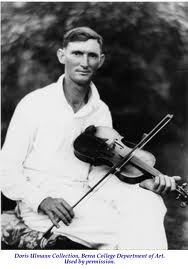Annotation:Indian Squaw (2): Difference between revisions
No edit summary |
No edit summary |
||
| Line 1: | Line 1: | ||
{{TuneAnnotation | {{TuneAnnotation | ||
|f_tune_annotation_title=https://tunearch.org/wiki/Annotation:Indian_Squaw_(2) > | |f_tune_annotation_title=https://tunearch.org/wiki/Annotation:Indian_Squaw_(2) > | ||
|f_annotation='''INDIAN SQUAW [2]'''. AKA and see "[[Banks of the Arkansas]]." American, Reel (cut time). G Major. GDad tuning (fiddle). AB. Some similarities to Alva Greene's version (see "[[Indian Squaw (1)]]"). Hiram Stamper's [http://www.berea.edu/hutchinslibrary/specialcollections/stamper.asp] (1883-1992) archaic version apparently was derived from a song. Stamper whistled to the 'B' part of the tune, and sang to the 'A' part: | |f_annotation='''INDIAN SQUAW [2]'''. AKA - "Two Little Indians and One Old Squaw." AKA and see "[[Banks of the Arkansas]]." American, Reel (cut time). G Major. GDad tuning (fiddle). AB. Some similarities to Alva Greene's version (see "[[Indian Squaw (1)]]"). Hiram Stamper's [http://www.berea.edu/hutchinslibrary/specialcollections/stamper.asp] (1883-1992) archaic version apparently was derived from a song. Stamper whistled to the 'B' part of the tune, and sang to the 'A' part: | ||
<blockquote> | <blockquote> | ||
''Way down yonder on the Arkansas,'' <br> | ''Way down yonder on the Arkansas,'' <br> | ||
| Line 9: | Line 9: | ||
Jeff Titon (2001) finds nearly the same lyric in a song called "[[Bank of the Arkansas (The)]]" printed in Lomax and Lomax's '''Our Singing Country''' (1941, pp. 68-69), although Titon says tune that appears with that song is the same as that of Clyde Davenport's "[[Cornstalk Fiddle]] and a Shoestring Bow." | Jeff Titon (2001) finds nearly the same lyric in a song called "[[Bank of the Arkansas (The)]]" printed in Lomax and Lomax's '''Our Singing Country''' (1941, pp. 68-69), although Titon says tune that appears with that song is the same as that of Clyde Davenport's "[[Cornstalk Fiddle]] and a Shoestring Bow." | ||
[[File:hiramstamper.jpg|260px|thumb|left|Hiram Stamper]] See also Missouri fiddler Bill Graves' "[[One Old Indian Two Old Squaws]]." See also Bruce Greene's version of Stamper's tune, as "[[Banks of the Arkansas]]." | [[File:hiramstamper.jpg|260px|thumb|left|Hiram Stamper]] See also Missouri fiddler Bill Graves' "[[One Old Indian Two Old Squaws]]." See also Bruce Greene's version of Stamper's tune, as "[[Banks of the Arkansas]]." | ||
|f_source_for_notated_version=Hiram Stamper (Hindman, Knott County, Ky., 1986), from an older fiddler, Shade Sloan [Titon]. | |f_source_for_notated_version=Hiram Stamper (Hindman, Knott County, Ky., 1986), from an older fiddler, Shade Sloan [Milliner-Koken, Titon]. | ||
|f_printed_sources= Titon (Old-Time Kentucky Fiddle Tunes), 2001; No. 69C, p. 99. | |f_printed_sources= Clare Milliner & Walt Koken ('''Milliner-Koken Collection of American Fiddle Tunes'''), 2011; p. 680. Titon ('''Old-Time Kentucky Fiddle Tunes'''), 2001; No. 69C, p. 99. | ||
|f_recorded_sources= | |f_recorded_sources=BG-CD1, Bruce Greene – “Five Miles of Ellum Wood” (1996. Learned from Hiram Stamper). | ||
|f_see_also_listing=Hear Stamper's 1986 field recording by Bob Butler at Berea Sound Archives [https://soundarchives.berea.edu/items/show/901] and at Slippery Hill [https://www.slippery-hill.com/recording/indian-squaw-2]}} | |f_see_also_listing=Hear Stamper's 1986 field recording by Bob Butler at Berea Sound Archives [https://soundarchives.berea.edu/items/show/901] and at Slippery Hill [https://www.slippery-hill.com/recording/indian-squaw-2]}} | ||
------------- | ------------- | ||
Latest revision as of 17:36, 18 March 2022
X:1 T:Indian Squaw [2] T:Two Little Indians and One Old Squaw N:From the playing of Knott County, east Kentucky, fiddler Hiram Stamper (1893-1991), N:recorded in the field in 1986 by Bob Butler M:C| L:1/8 N:Play with some 'swing' R:Reel D:https://www.slippery-hill.com/content/two-little-indians-and-one-old-squaw Z:Transcribed by Andrew Kuntz K:G B2-d2 d2d2|d2 d=f- e2d2|[G,3G3]A B2d2|d2de d2B2|A2G2 (D2 EF)| D8|B2dd dd d2-|d2 fd e2d2|B2-Bd (3BdB AA| G2 AB A2G2E3c| BGAG GB3|A2G2E2c2|(3BcB AG GGBG- |D2E2 {E}[G,3G3]B| BGAG EE [GB]A|G2 AG EE ([Ec]A)|(3BcB AG GGBG- |D2E2 (G,G3)|[M:2/4] G4||
INDIAN SQUAW [2]. AKA - "Two Little Indians and One Old Squaw." AKA and see "Banks of the Arkansas." American, Reel (cut time). G Major. GDad tuning (fiddle). AB. Some similarities to Alva Greene's version (see "Indian Squaw (1)"). Hiram Stamper's [1] (1883-1992) archaic version apparently was derived from a song. Stamper whistled to the 'B' part of the tune, and sang to the 'A' part:
Way down yonder on the Arkansas,
Two old Indians and one old squaw,
Sitting on the banks of the Arkansas.
Jeff Titon (2001) finds nearly the same lyric in a song called "Bank of the Arkansas (The)" printed in Lomax and Lomax's Our Singing Country (1941, pp. 68-69), although Titon says tune that appears with that song is the same as that of Clyde Davenport's "Cornstalk Fiddle and a Shoestring Bow."


